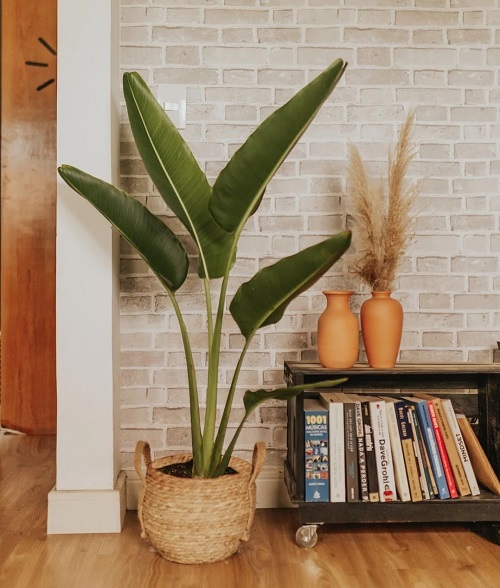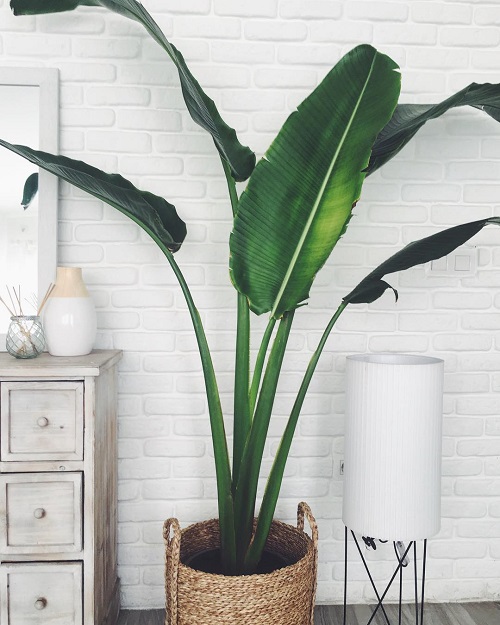Want to grow Ravenala madagascariensis for its statement-making long, banana-like leaves? Check out this Travelers Palm Indoor care guide!

Traveler’s palms are well-known among houseplant enthusiasts for their impressive foliar display, easy-to-care nature, and clusters of creamy white blooms. That’s why if you’re thinking about growing this outstanding plant in your living space, read this travelers palm growing and caring guide!
- Botanical Name: Ravenala madagascariensis
- Other Names: Pokok Travelers, Traveller’s Tree, and Pisang Kipas
Travelers Palm Information
Native to Madagascar, Travelers Palm is a member of the Strelitziaceae family with banana-like, fan-shaped leaves that can reach a length of about 10 feet. This plant gets its common name because weary travelers would quench their thirst by drinking the rainwater stored in the enlarged sheaths of the leaf bases.
Traveler’s palm is prized for its outstanding foliar display, but it also offers clusters of creamy white blooms on 1’–2′ long stalks. As this plant is a slow grower, it’ll take around a decade to bloom.
Ideal Pot Size For Travelers’ Palm
The giant stature of Ravenala madagascariensis calls for a 14-16 inches tall sturdy container while starting out. If you have enough space to accommodate a big Travelers Palm, keep repotting the plant to 1-2 sized bigger containers every two years.
Propagating Travelers Palm

The quickest and most popular method to propagate this plant is to locate rooted suckers, which grow near the main stem. When you see the Travelers Palm exceeding the planter size, take the plant out gently from the pot and detangle the root ball. It might be challenging, but ensure that the foliage will not get hurt in the process.
Then, separate the offsets from the mother plant; use a sterilized knife if required. The next step is to plant the sucker in a well-draining, moist medium. To cut down the hassle of transplanting, get a big pot and watch your Travelers Palm thrive indoors.
Tip: The ideal time to follow this process is at the beginning of the rainy season.
Requirements For Growing Travelers Palm Indoors

Soil
Travelers Palm grows best in rich, loamy soil with mild acidity. The medium must be moist but not waterlogged. Ensure that the soil contains lots of organic matter, such as coco coir and perlite or vermiculite, to boost drainage.
Light
Travelers palm prefer indirect sunlight in the earlier stage and gradually require more light at maturity. Once established, it can thrive close to bright, sunny windows. Place your potted palm less than 1ft from a south-facing window for the best foliar display.
Temperature and Humidity
This palm has a narrower temperature tolerance and grows well in USDA zones 10 to 11. Temperatures below 15 degrees Celsius are bad for its growth and will damage the plant. Traveller’s Palm cannot tolerate anything below 5 degrees Celsius and can die under such conditions. The optimal temperature range is 65-85 F or 18-29 C.
This plant needs high humidity indoors. Keep a humidifier handy for the drier days.
Water
While growing Travelers Palm indoors, ensure the medium is evenly moist but not soggy. Keep an eye on the top 1-2 inches and water whenever it dries out. Also, make sure the soil doesn’t stay dry for long.
Traveler’s Palm Indoor Care

Fertilizer
Feed the Ravenala madagascariensis with a slow-release fertilizer once a month during the summer and rainy seasons. It’s highly recommended to add a nitrogen-rich fertilizer, which will result in a healthier and faster-growing palm.
Pest and Disease
Traveler’s palm does not fall prey to most of the pests or diseases. However, it has been known to host Colletotrichum gloeosporioides and is susceptible to various forms of leaf spot and root rot. Spider mites have also been seen to infest this tree.
Pruning
This plant can be pruned once in a while to make it look neat and control its spread. Use a sharp tool to prune because dull cutting tools will shred your Traveler’s Palm, causing fungal issues.






